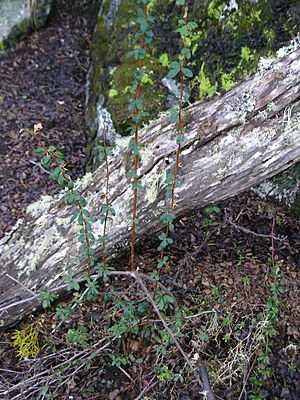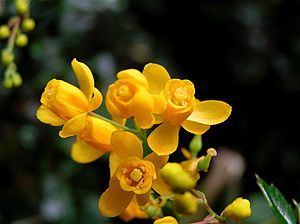Berberis microphylla facts for kids
The Calafate (Berberis microphylla) is a special evergreen shrub. It is also known as box-leaved barberry or Magellan barberry. In Spanish, people call it calafate or michay. This plant is native to southern Argentina and Chile. It is a well-known symbol of the Patagonia region.
Quick facts for kids Berberis microphylla |
|
|---|---|
 |
|
| Calafate (Berberis microphylla) | |
| Scientific classification | |
| Genus: |
Berberis
|
| Species: |
microphylla
|
Contents
What Does the Calafate Look Like?
The Calafate bush usually grows to be about 1 to 1.5 meters (3 to 5 feet) tall. It has many branches that arch outwards. Each branch is covered with sharp, three-part spines.
The leaves are simple, shiny, and look a bit like the leaves of a boxwood plant. In the summer, the bush produces many small, bright yellow flowers.
Calafate Berries and a Special Legend
After the flowers, the Calafate bush grows small, edible blue-black berries. People pick these berries to make delicious jams. They also enjoy eating them fresh.
There is a famous legend about the Calafate berry. It says that anyone who eats a Calafate berry will surely return to Patagonia someday. This makes the berry even more special to the region.
How is the Calafate Plant Used?
The Calafate plant is important for several reasons:
- For its Fruit: The berries are harvested and sold for food products like jams.
- In Gardens: It is grown as a garden plant. A special type called Berberis microphylla 'Nana' is very popular. This type is often used as a low, spiny hedge. It helps to keep unwanted visitors out of gardens, but it does not produce fruit.
- For Dye: The wood of the Calafate plant can be used to make a red dye.
- Possible Medical Uses: Scientists are also studying the plant for its potential health benefits.
Not to Be Confused With Other Plants
It is important not to mix up Berberis microphylla with another plant called Mahonia microphylla. The Mahonia microphylla is a different plant that comes from China.
See also
 In Spanish: Calafate para niños
In Spanish: Calafate para niños



